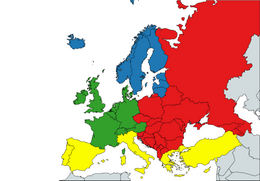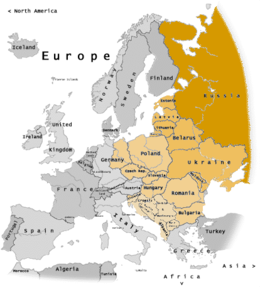Central and Eastern Europe is a geopolitical term encompassing the countries in Northeast Europe (primarily the Baltics), Central Europe, Eastern Europe, and Southeast Europe (primarily the Balkans), usually meaning former communist states from the Eastern Bloc and Warsaw Pact in Europe, as well as from former Yugoslavia. Scholarly literature often uses the abbreviations CEE or CEEC for this term.[1][2][3] The Organisation for Economic Co-operation and Development (OECD) also uses the term "Central and Eastern European Countries" (CEECs) for a group comprising some of these countries. This term is sometimes used for "Eastern Europe" instead for more neutral grouping.[4][5][6][7][8]
 Central and Eastern Europe |
 |
Definitions edit
The term CEE includes the Eastern Bloc (Warsaw Pact) countries west of the post-World War II border with the former Soviet Union; the independent states in former Yugoslavia (which were not considered part of the Eastern bloc); and the three Baltic states – Estonia, Latvia, Lithuania (which chose not to join the CIS with the other 12 former republics of the USSR).
The CEE countries are further subdivided by their accession status to the European Union (EU): the eight first-wave accession countries that joined the EU on 1 May 2004 (Estonia, Latvia, Lithuania, Czech Republic, Slovakia, Poland, Hungary, and Slovenia), the two second-wave accession countries that joined on 1 January 2007 (Romania and Bulgaria) and the third-wave accession country that joined on 1 July 2013 (Croatia). According to the World Bank 2008 analysis, the transition to advanced market economies is over for all 10 countries that joined the EU in 2004 and 2007.[9]
The CEE countries include the former socialist states, which extend east of Austria, Germany (western part), and Italy; north of Greece and Turkey (European part); south of Finland and Sweden; and west of Belarus, Moldova, Russia, and Ukraine:
| Country | European Union | NATO | Notes | |
|---|---|---|---|---|
| Albania | Candidate negotiating | Member state | ||
| Bosnia and Herzegovina | Candidate | Membership Action Plan | ||
| Bulgaria | Member state | Member state | [10][11] | |
| Croatia | Member state | Member state | [10][11] | |
| Czech Republic | Member state | Member state | [10][11] | |
| Estonia | Member state | Member state | [10][11] | |
| Hungary | Member state | Member state | [10][11] | |
| Kosovo | Applicant | — | Partially recognized state | |
| Latvia | Member state | Member state | [10][11] | |
| Lithuania | Member state | Member state | [10][11] | |
| Montenegro | Candidate negotiating | Member state | ||
| North Macedonia | Candidate negotiating | Member state | [10][11] | |
| Poland | Member state | Member state | [10][11] | |
| Romania | Member state | Member state | [10][11] | |
| Serbia | Candidate negotiating | Individual Partnership Action Plan | ||
| Slovakia | Member state | Member state | [10][11] | |
| Slovenia | Member state | Member state | [10][11] | |
| Abkhazia | — | — | Partially recognized state[12] | |
| Armenia | — | Individual Partnership Action Plan | Member state of CIS and CSTO | |
| Azerbaijan | — | Individual Partnership Action Plan | Member state of CIS | |
| Belarus | — | — | Member state of CIS and CSTO | |
| Georgia | Candidate | Intensified Dialogue | ||
| Moldova | Candidate | Individual Partnership Action Plan | Member state of CIS | |
| Russia | — | — | Member state of CIS and CSTO | |
| South Ossetia | — | — | Partially recognized state[13] | |
| Transnistria | — | — | Partially recognized state[14] | |
| Ukraine | Candidate | Intensified Dialogue | ||
According to the Organisation for Economic Co-operation and Development, "Central and Eastern European Countries (CEECs) is an OECD term for the group of countries comprising Albania, Bulgaria, Croatia, the Czech Republic, Hungary, Poland, Romania, the Slovak Republic, Slovenia, and the three Baltic States: Estonia, Latvia and Lithuania."[11]
The term Central and Eastern Europe (abbreviated CEE) has displaced the alternative term East-Central Europe in the context of transition countries, mainly because the abbreviation ECE is ambiguous: it commonly stands for Economic Commission for Europe, rather than East-Central Europe.[15]
See also edit
References edit
- ^ Inotai, András (Autumn 2009). "BUDAPEST—Ghost of Second-Class Status Haunts Central and Eastern Europe". Europe's World. Archived from the original on 2013-01-12. Retrieved 2012-09-04.
- ^ Z. Lerman, C. Csaki, and G. Feder, Agriculture in Transition: Land Policies and Evolving Farm Structures in Post-Soviet Countries, Lexington Books, Lanham, MD (2004), see, e.g., Table 1.1, p. 4.
- ^ J. Swinnen, ed., Political Economy of Agrarian Reform in Central and Eastern Europe, Ashgate, Aldershot (1997).
- ^ Mälksoo, Maria (2019-05-04). "The normative threat of subtle subversion: the return of 'Eastern Europe' as an ontological insecurity trope". Cambridge Review of International Affairs. 32 (3): 365–383. doi:10.1080/09557571.2019.1590314. ISSN 0955-7571. S2CID 159184190.
- ^ Twardzisz, Piotr (2018-04-25). Defining 'Eastern Europe': A Semantic Inquiry into Political Terminology. Springer. p. 18. ISBN 978-3-319-77374-2.
- ^ Hall, Derek (July 1999). "Destination branding, niche marketing and national image projection in Central and Eastern Europe". Journal of Vacation Marketing. 5 (3): 227–237. doi:10.1177/135676679900500303. ISSN 1356-7667. S2CID 154698941.
- ^ Zarycki, Tomasz (2014). Ideologies of Eastness in Central and Eastern Europe. doi:10.4324/9781315819006. ISBN 9781317818571. S2CID 129401740.
- ^ Kalnoky, Boris. "Eastern promise and Western pretension – 09/07/2018". DW. Retrieved 2022-11-16.
- ^ Alam, Asad; Anós Casero, Paloma; Khan, Faruk; Udomsaph, Charles (2008). "Unleashing Prosperity: Productivity Growth in Eastern Europe and the Former Soviet Union" (PDF). Washington, D.C.: World Bank. p. 42. Archived from the original (PDF) on Nov 28, 2018.
- ^ a b c d e f g h i j k l "CEE countries". Weastra. 9 August 2011. Archived from the original on Sep 6, 2022.
{{cite web}}: CS1 maint: unfit URL (link) - ^ a b c d e f g h i j k l m "Central and Eastern European Countries (CEECs) Definition". OECD Glossary of Statistical Terms. OECD Statistics. November 2, 2001. Archived from the original on Oct 25, 2022.
- ^ The political status of Abkhazia is disputed. Having unilaterally declared independence from Georgia in 1992, Abkhazia is formally recognised as an independent state by 5 UN member states (two other states previously recognised it but then withdrew their recognition), while the remainder of the international community recognizes it as as de jure Georgian territory. Georgia continues to claim the area as its own territory, designating it as Russian-occupied territory.
- ^ South Ossetia's status is disputed. It considers itself to be an independent state, but this is recognised by only a few other countries. The Georgian government and most of the world's other states consider South Ossetia de jure a part of Georgia's territory.
- ^ Transnistria's political status is disputed. It considers itself to be an independent state, but this is not recognised by any UN member state. The Moldovan government and the international community consider Transnistria a part of Moldova's territory.
- ^ "UNECE Homepage". unece.org.